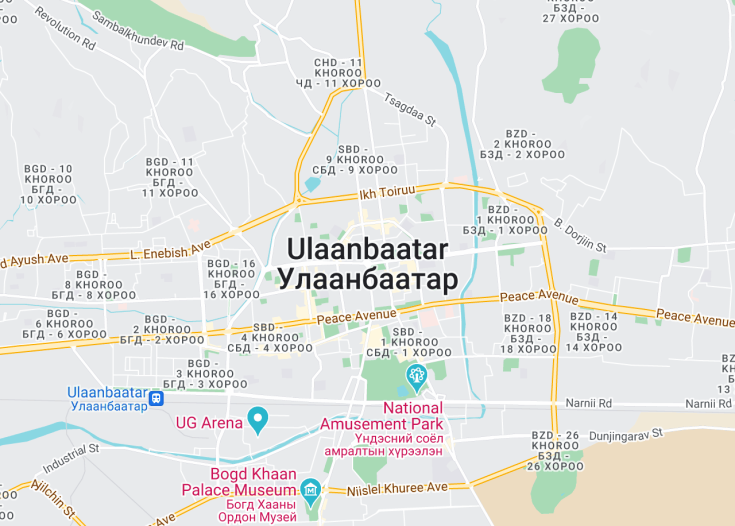Ulaanbaatar, the capital of Mongolia, stands as a vibrant blend of ancient tradition and modernity. Nestled in a valley and surrounded by four sacred mountains, it serves as the cultural, industrial, and financial heart of the country. This city offers a unique glimpse into Mongolia’s rich heritage through its historic monasteries and museums while also displaying rapid growth and development. Despite its cold climate, Ulaanbaatar attracts tourists with its lively festivals and dynamic urban atmosphere. Whether it’s exploring the historic Gandan Monastery or experiencing the bustling Naran Tuul Market, Ulaanbaatar offers an intriguing mix of old and new.
When visiting Ulaanbaatar, dress warmly regardless of the season, as temperatures can remain brisk. Also, try to catch the Naadam Festival, showcasing traditional Mongolian sports and culture.
Plan your trip outside of the harsh winter months for a more comfortable exploration of the city’s outdoor attractions like the Bogd Khan Palace Museum.
Ulaanbaatar: Gateway to the Mongolian Heartland
| Country | Mongolia |
| Time in Ulaanbaatar | GMT+8 |
| Language spoken | Mongolian |
| Population | 1,553,971 (Data source: National Statistics Office of Mongolia, 2022) |
| Currency | Mongolian Tögrög (Symbol: ₮, Code: MNT) |
| Airports |
|
Ulaanbaatar, the capital city of Mongolia, is a blend of modernity and tradition. Nestled in the valley of the Tuul River and surrounded by four sacred mountains, it is both the cultural and economic heart of the country. Throughout its history, from a nomadic settlement to a Soviet-style city, Ulaanbaatar has been a site of continuous transformation. Today, it juxtaposes ger districts, traditional tent communities, with towering skyscrapers, symbolizing Mongolia’s aspirations in the global context. The city’s history spans centuries, marked significantly by its role in the propagation of Buddhism in Mongolia and its strategic position on the Silk Road. Modern Ulaanbaatar is also a hub for cultural festivals, such as Naadam, which showcases Mongolian wrestling, horse racing, and archery, drawing visitors from around the world.
Where is Ulaanbaatar?
Ulaanbaatar is located in northern Mongolia, situated between four sacred mountains in the valley of the Tuul River near the Gorkhi-Terelj National Park.
Distances:
| Route | Distance by car | Time by car |
|---|---|---|
| From Darhan to Ulaanbaatar | 230 km | 3h 30m |
| From Erdenet to Ulaanbaatar | 371 km | 5h 45m |
What is Ulaanbaatar famous for?
Ulaanbaatar is renowned for its unique blend of Mongolian cultural heritage and urban growth. It earns distinction for hosting the Naadam Festival, an intangible cultural heritage recognized by UNESCO.
History
Ulaanbaatar, the capital of Mongolia, boasts a rich tapestry of history that dates back to its origins as a nomadic Buddhist monastic center. It was founded in 1639 as Örgöö (translated to “Palace”) and has since undergone numerous transformations, both in name and location, reflecting its deep historical and cultural significance.
1639-1700: The Formation and Early Years
Ulaanbaatar started as a movable monastery tent city, changing locations along the banks of the Selbe River. Its initial purpose was to serve as a religious center for the introduction and spread of Tibetan Buddhism in Mongolia.
1700-1911: Stability and Growth
The city settled permanently at its present location in 1778, where it was known as Ikh Khüree, or “Great Camp”. Throughout the 18th and 19th centuries, it blossomed as a major center of religion and Mongolian culture, harboring a significant number of monasteries and thousands of monks.
1911-1924: Towards Independence
In 1911, with the fall of the Qing Dynasty, Mongolia declared independence, and Ikh Khüree became the seat of the new government. However, true autonomy was short-lived; it became a focal point for Soviet influence by the early 1920s.
1924-Present: Modernization and Development
In 1924, following the establishment of the Mongolian People’s Republic, the city was renamed Ulaanbaatar, which means “Red Hero”. The 20th and 21st centuries have seen continued development, with Ulaanbaatar evolving into a vibrant urban hub, balancing modernity with its rich historic roots.
Visit Ulaanbaatar
What to see and do in Ulaanbaatar, Mongolia.
Ulaanbaatar is a city where ancient traditions and modern life blend seamlessly. Visitors can explore a number of fascinating attractions:
- The Gandan Monastery, a vibrant center of Mongolian Buddhism.
- The National Museum of Mongolia, which provides insights into the rich tapestry of the country’s history.
- Sükhbaatar Square, the central and most symbolic square of the city.
- Zaisan Memorial, offering panoramic views of Ulaanbaatar.
- The Genghis Khan Statue Complex, located a short drive from the city.
These landmarks provide a deep dive into the cultural heritage and the dynamic evolution of this unique capital.
Festivities and Events in Ulaanbaatar
Ulaanbaatar hosts several culturally significant events throughout the year, notably:
- The Naadam Festival, occurring in July, showcasing traditional Mongolian sports like wrestling, archery, and horse racing.
- The Golden Eagle Festival, a spectacular display of traditional eagle hunting, typically held in October.
These events offer a glimpse into the traditional Mongolian way of life and provide stimulating experiences for visitors.
Best time to visit Ulaanbaatar
The best time to visit Ulaanbaatar is during the summer months, from June to August, when the weather is warmest and the city is vibrant with activities and festivals. This period provides an ideal climate for exploring both the city and the beautiful landscapes of Mongolia.
Is Ulaanbaatar worth visiting?
Ulaanbaatar is undoubtedly worth visiting for those intrigued by a blend of historic charm and modern dynamism. The city serves as a cultural hub of Mongolia, offering a rare peek into Mongolian traditions through its monasteries, museums, and festivals. With its unique position between vast steppes and modern development, Ulaanbaatar provides a compelling destination, rich in cultural, historical, and natural attractions.









